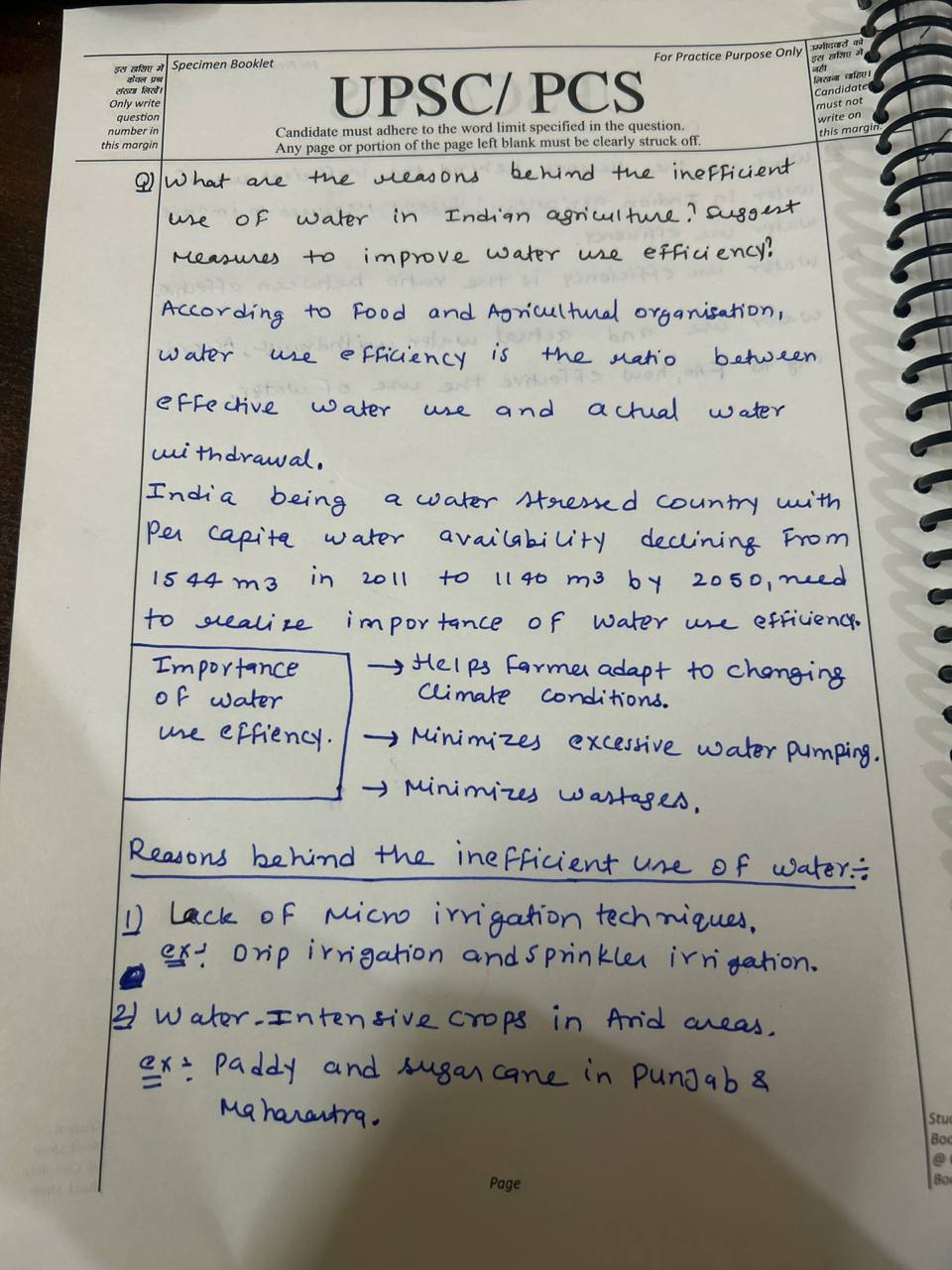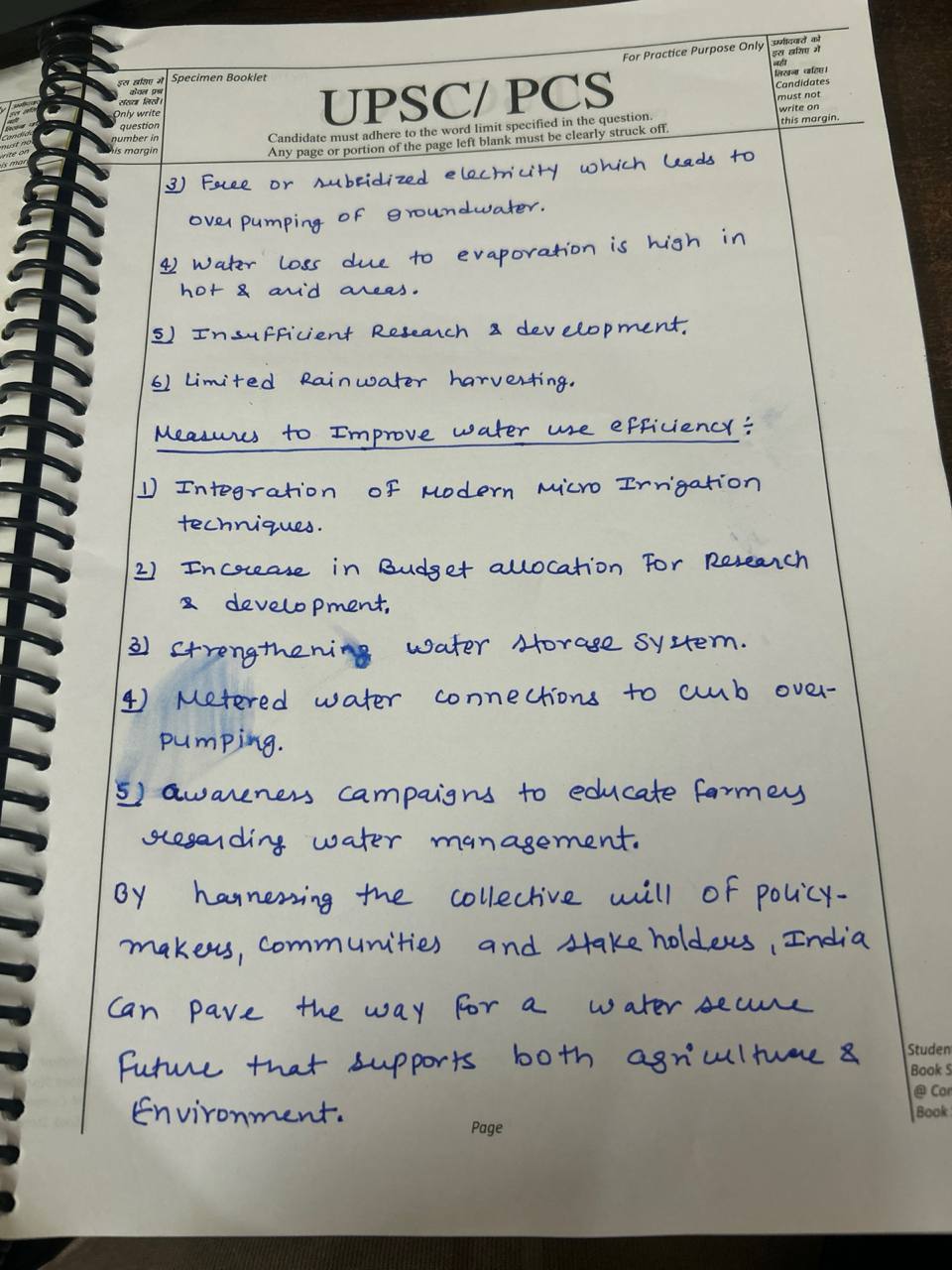What obstacles does crop diversification face today? In what ways may developing technology help diversify agricultural production? (250 words) [UPSC 2021]
Model Answer Introduction The rice-wheat cropping system is India’s most widely adopted agricultural practice, covering approximately 11 million hectares, primarily in the Indo-Gangetic plains. This system involves cultivating rice during the summer monsoon and wheat in the winter, predominantly inRead more
Model Answer
Introduction
The rice-wheat cropping system is India’s most widely adopted agricultural practice, covering approximately 11 million hectares, primarily in the Indo-Gangetic plains. This system involves cultivating rice during the summer monsoon and wheat in the winter, predominantly in states like Uttar Pradesh, Punjab, Haryana, Bihar, and West Bengal.
Major Factors for Success
- Green Revolution: The introduction of high-yielding varieties (HYVs) and advanced agricultural technologies significantly boosted food grain production, particularly rice and wheat. Enhanced irrigation facilities and machinery further increased productivity and cropping area.
- Minimum Support Price (MSP) Policies: The government’s procurement of rice and wheat at MSP has insulated farmers from market risks, encouraging a shift towards these crops.
- Food Preferences: Rice and wheat are staple foods in India, leading subsistence farmers to cultivate these crops for personal consumption.
- Favorable Agro-climatic Conditions: The warm, humid climate and fertile soils in the rice-wheat belt support high yields, making it an ideal region for this cropping system.
- Allied Activities: The system also supports livestock farming through the provision of green fodder, enhancing overall agricultural productivity.
Bane of the Rice-Wheat System
Despite its success, the rice-wheat system has led to several ecological and economic issues:
- Groundwater Depletion: The reliance on groundwater for irrigation, exacerbated by free power policies, has led to severe depletion, particularly in Punjab and Haryana, which are now over-exploited zones.
- Environmental Pollution: Crop residue burning in states like Punjab and Haryana contributes to significant air pollution, while excessive use of fertilizers has resulted in soil degradation and water contamination.
- Loss of Biodiversity: The focus on hybrid seeds and monoculture practices has diminished biodiversity, making crops more susceptible to pests and diseases.
- Economic Challenges: Rising labor costs and exposure to global markets have reduced farmers’ incomes, with productivity levels in India lagging behind international standards, such as those in China.
- Lack of Innovation: The long-standing MSP system has stifled farmers’ entrepreneurial skills and innovation, leading to unsustainable agricultural practices.
Conclusion
To address these challenges, India must adopt innovative agricultural strategies, diversify cropping patterns, and enhance market access for farmers. An Ever-Green Revolution is essential for sustainable agricultural growth and the future of rural youth.
See less


Present Challenges Before Crop Diversification **1. Monoculture Dependency: Many regions in India rely heavily on monoculture, particularly the cultivation of a single crop like paddy or wheat, due to traditional practices and market incentives. This dependency limits the adoption of diverse croppinRead more
Present Challenges Before Crop Diversification
**1. Monoculture Dependency: Many regions in India rely heavily on monoculture, particularly the cultivation of a single crop like paddy or wheat, due to traditional practices and market incentives. This dependency limits the adoption of diverse cropping systems.
**2. Inadequate Infrastructure: The lack of sufficient irrigation facilities, market access, and storage infrastructure hampers the ability of farmers to switch to new or diverse crops. For example, regions with insufficient irrigation often focus on water-intensive crops like paddy.
**3. Economic Viability: Farmers may be reluctant to diversify due to the economic risks associated with new crops, such as uncertain market prices and yield. For instance, growing high-value crops like fruits and vegetables requires investment and risk management which many smallholders might not afford.
**4. Lack of Knowledge and Extension Services: There is often a knowledge gap about the benefits and techniques of crop diversification. Agricultural extension services may be insufficient in providing the necessary training and support to farmers.
Emerging Technologies Providing Opportunities for Crop Diversification
**1. Precision Agriculture: Technologies like drones, satellite imagery, and soil sensors help in assessing soil health and optimizing crop selection. For instance, Precision Farming provides data on soil conditions that can guide farmers in choosing appropriate crops for their land.
**2. Genetic Engineering: Advances in crop genetics have led to the development of drought-resistant and high-yielding varieties of diverse crops. The introduction of GM crops like Bt cotton and biofortified crops helps in adapting to varying climatic conditions.
**3. Climate-Smart Agriculture: Climate-resilient farming practices supported by technology, such as drip irrigation and rainwater harvesting, enable farmers to cultivate a variety of crops even under adverse weather conditions.
**4. Digital Platforms: Agri-tech platforms and mobile apps provide real-time market information, weather forecasts, and expert advice, helping farmers make informed decisions about crop diversification. For example, apps like Kisan Suvidha offer critical insights that support crop diversification strategies.
**5. Supply Chain Innovations: Cold storage solutions and efficient logistics supported by technology improve the marketability and shelf-life of diverse crops, encouraging farmers to grow high-value crops like fruits and vegetables.
Conclusion: While crop diversification faces challenges such as monoculture dependency, inadequate infrastructure, and economic risks, emerging technologies offer significant opportunities to overcome these barriers. By leveraging precision agriculture, genetic engineering, climate-smart practices, and digital platforms, farmers can enhance their ability to diversify crops, leading to more resilient and sustainable agricultural systems.
See less